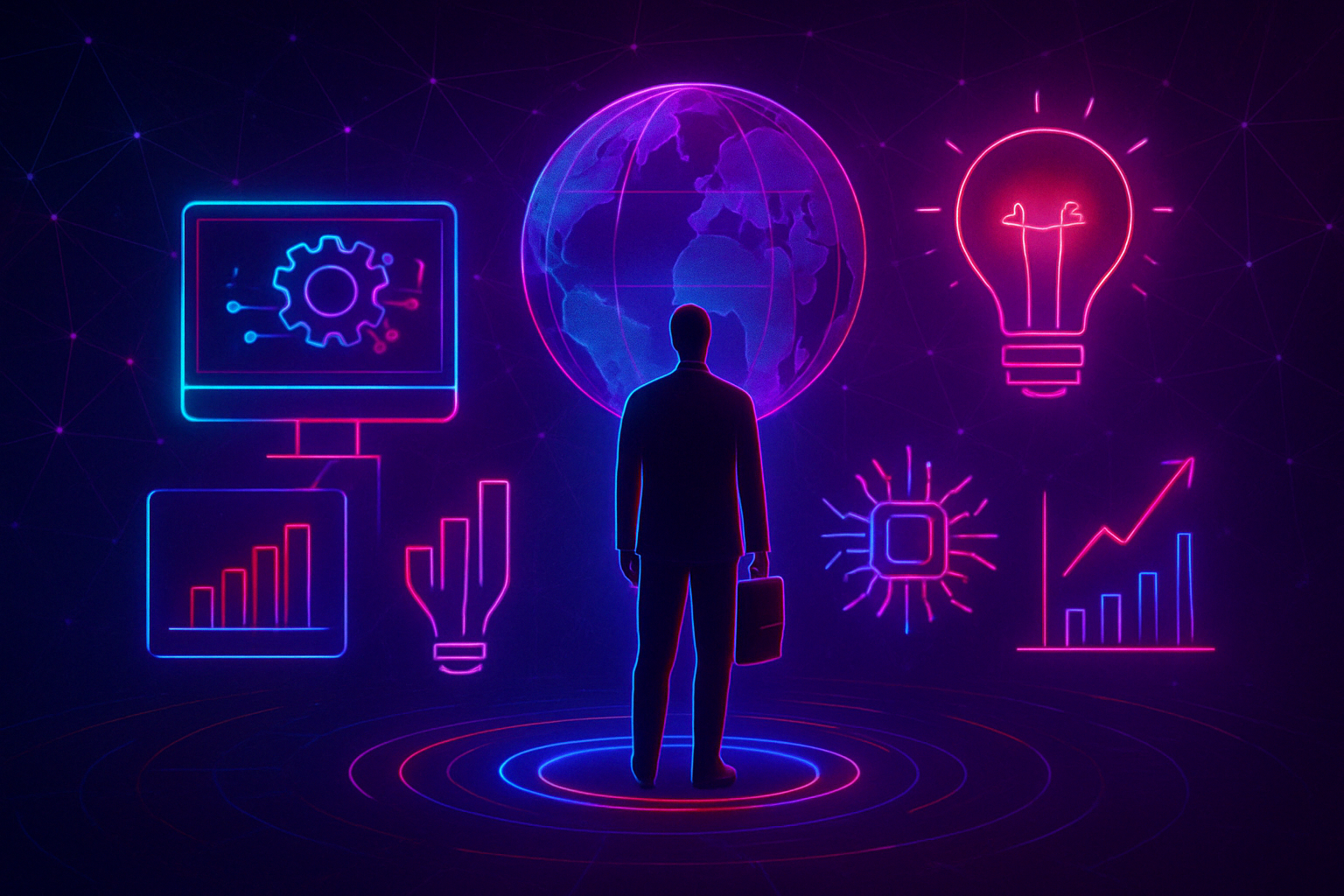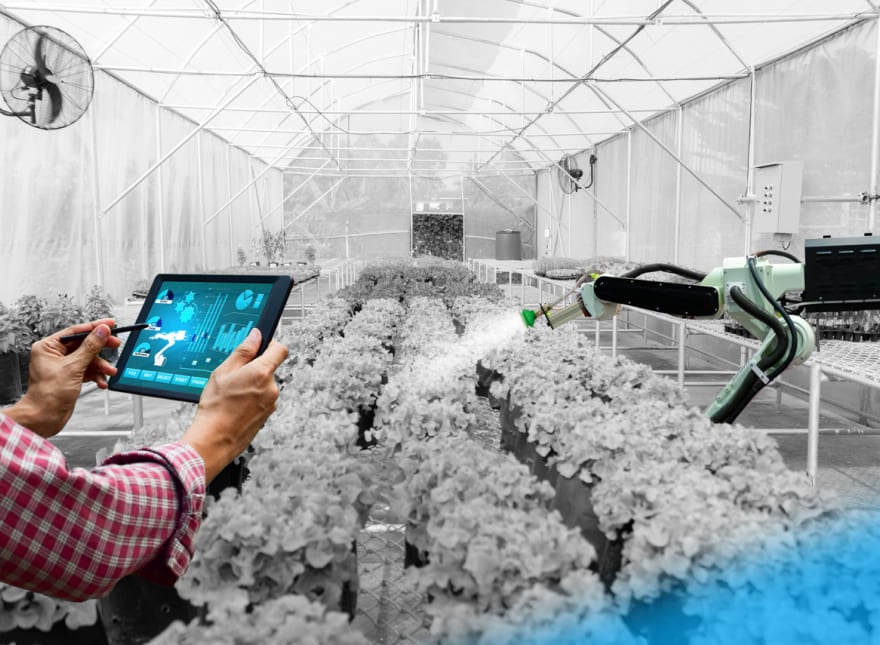Check out our latest blog article: From component to enterprise – modular robotics done right.
How IoT Makes Cities Smart and Sustainable: Key Applications

New York needs over 1,150 garbage trucks every day. Boston is struggling with traffic jams: it’s the most congested city in the country. Miami consumes more electricity per person than any other city in the U.S. These are true challenges for citizens and local authorities.
IoT-powered waste management, connected cars, and smart utility meters are real examples of how smart city technology helps make public areas more livable and sustainable. Municipal governments need solutions to make infrastructure and services greener—and smarter. For many companies, it’s time to go climate tech, meeting new business opportunities along the way.
Why Go Climate Tech?
Scientists blame cities for more than 70% of global CO2 emissions. The guilty parties here are intense traffic, pollution from industrial plants and buildings, and inefficient public transport. All together they cause significant environmental issues.
So it’s no surprise that governments worldwide are introducing new, stricter regulations to decrease the level of CO2 emissions. New rules address companies, whole industries, and municipal authorities. In 2021, 124 countries are committed to reaching carbon neutrality by 2050.
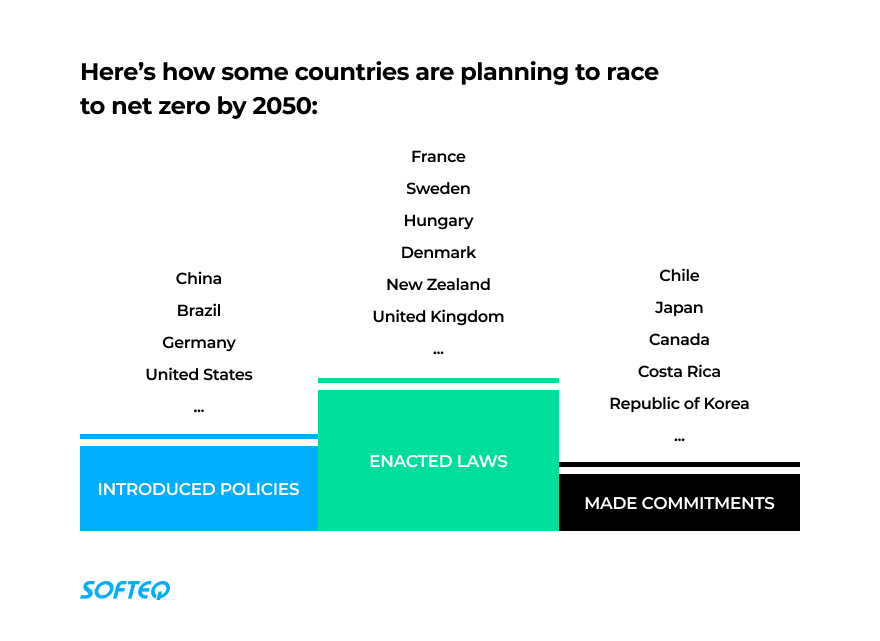
To achieve this timeline, cities need help meeting new targets. IoT technology can step in to assist. You cannot change what you cannot measure, right? Sensors can measure everything. And when data is not only generated but also shared between objects, a connected city, with all of the benefits that brings, is possible.
Today’s connected cities need smart utility meters, smart grids, and smart waste management solutions to reduce carbon emissions. This can be a boon to climate tech startups. It can also bring profit to oil & gas, utility, or construction companies who have stepped into the green side.
Earlier climate tech companies had a narrow focus on renewable energy. Unluckily, many of them didn’t return the invested capital. But today, everything has changed. Now, a broad set of sectors can contribute to a sustainable economy.
The Stanford Social Innovation Review divides climate tech companies into five green categories. They address the global challenge by:
- Moving the energy supply to renewable sources
- Going for zero-emission in transportation
- Reducing the impact of buildings and infrastructure
- Ensuring sustainable agriculture, forestry, and other land use
- And decreasing the carbon effect in industrial processes
Broadly speaking, any company working to decarbonize the economy is part of climate tech today. People’s interest has increased. New business talent and technical advances are wanted.
What about money? As of 2019, the climate tech sector had seen a fivefold increase in investments over the previous 10 years and had reached $264 billion. Of course, the pandemic affected this market as it did many others. But experts claim that climate tech remains an increasingly important investment frontier. GreenBiz interviewed eight tech investment firms during the full swing of the pandemic; all of them affirmed their support for climate tech companies. Climate tech is both necessary and trendy.

How IoT Transforms a City
The concept of a smart city revolves around data collected from cars, public transportation, citizens, buildings, and infrastructure and shared between stakeholders and smart services. Smart city technology helps city managers control various aspects of city functioning. These include energy distribution, water quality, waste collection, air quality, security, and mobility. Such IoT solutions can function separately or can connect with each other, creating complex ecosystems. Through this, municipal authorities can arrange and manage assets and services more efficiently.
Here are some possible scenarios of IoT usage in connected cities:
- Connected traffic lights receive data from sensors and respond to real-time traffic
- Smart energy grids collect data from buildings so utility companies can manage energy efficiently
- Smart trash cans transfer data to waste management companies to schedule pick-up
- Vehicles connect with parking facilities to find open spots and decrease traffic congestion
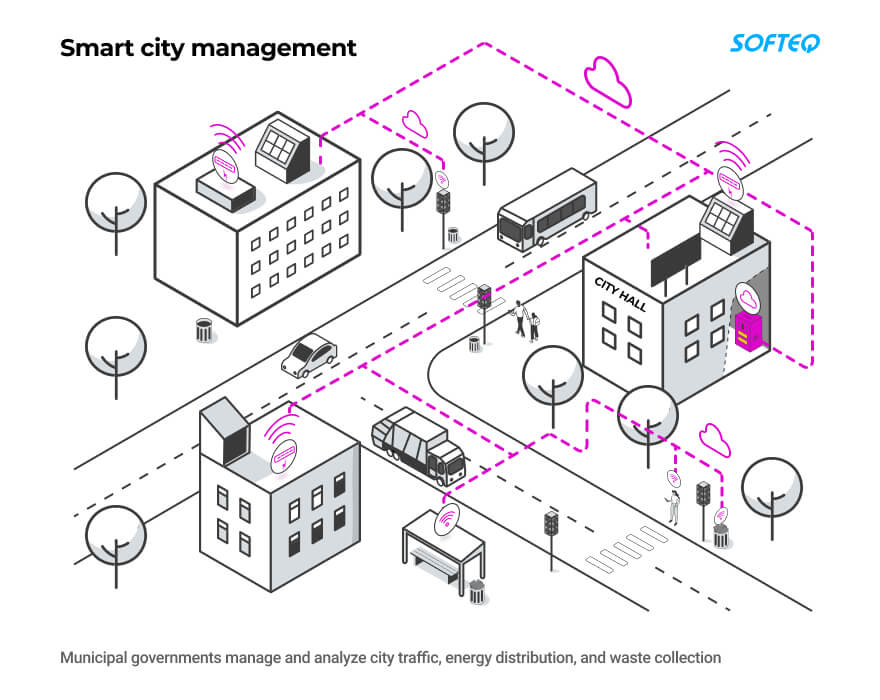
From the tech side, these solutions all function thanks to sensors, gateways, cloud platforms, and web and mobile applications. Sensors collect data and transmit it to the cloud via the Internet. The cloud platform analyzes sensor data and produces actionable insights. Artificial intelligence in the pipeline helps process and analyze data, but also take immediate actions. All information is represented in dashboards and is normally accessible from a smartphone.
Three groups of key city players make all this happen—local authorities, climate tech companies, and residents. Climate tech companies build “green” business models and scale tech solutions for clean energy. Municipalities and citizens make wiser decisions for the economy, for sustainability, and for a better life.
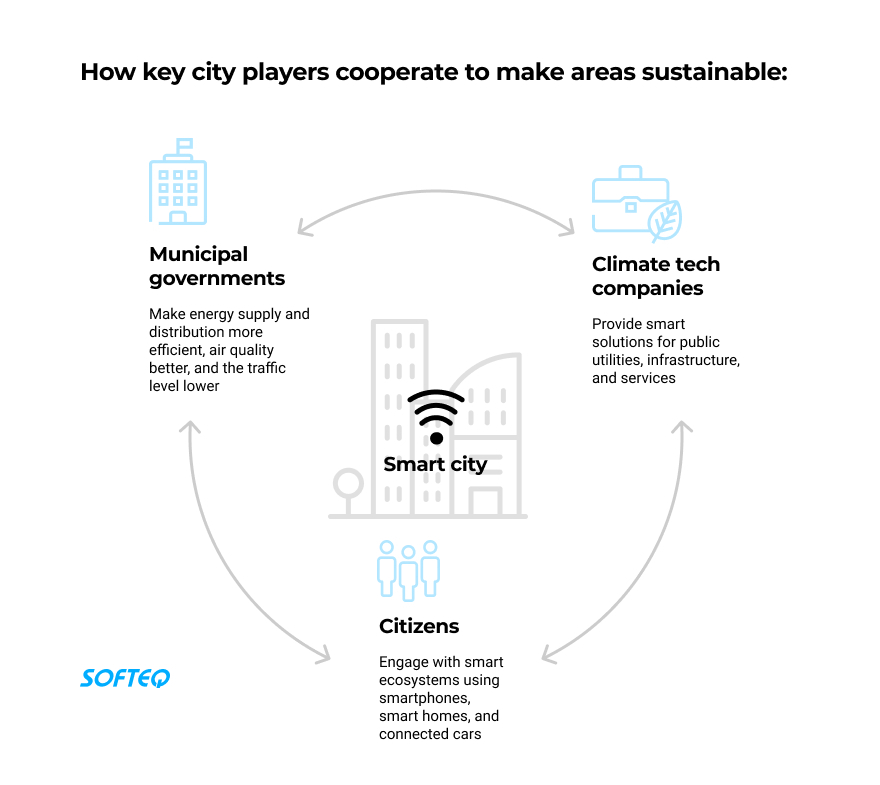
3 Examples of Green Application Areas in a Smart City
There’re many ways that smart city technology can empower municipal authorities. Over 70% of cities use IoT systems for traffic, security, and water level monitoring. Take a look at the most popular IoT applications in a smart city.
Smart utility meters
Smart meters replaced analog meters for tracking electricity, gas, and water consumption. An individual device attaches to a building and connects to a smart energy grid. No need for human interaction. A utility company gets accurate meter readings from sensor data in real time.
Thus, providers can analyze usage and forecast demand for electricity or water, optimizing distribution. It’s also possible to detect leaks or supply issues immediately. This helps manage utility consumption more sustainably—decreasing consumption and also saving money.
IoT companies don't produce smart devices only—they help make greener choices. Although a smart device doesn’t save energy, it motivates us to care about saving gas or electricity. People see different prices for the same, for example, electricity usage, and start choosing off-peak times. And even opt for renewable energy where possible. Companies, in turn, also save costs and decrease CO2 emissions associated with traveling for meter readings.
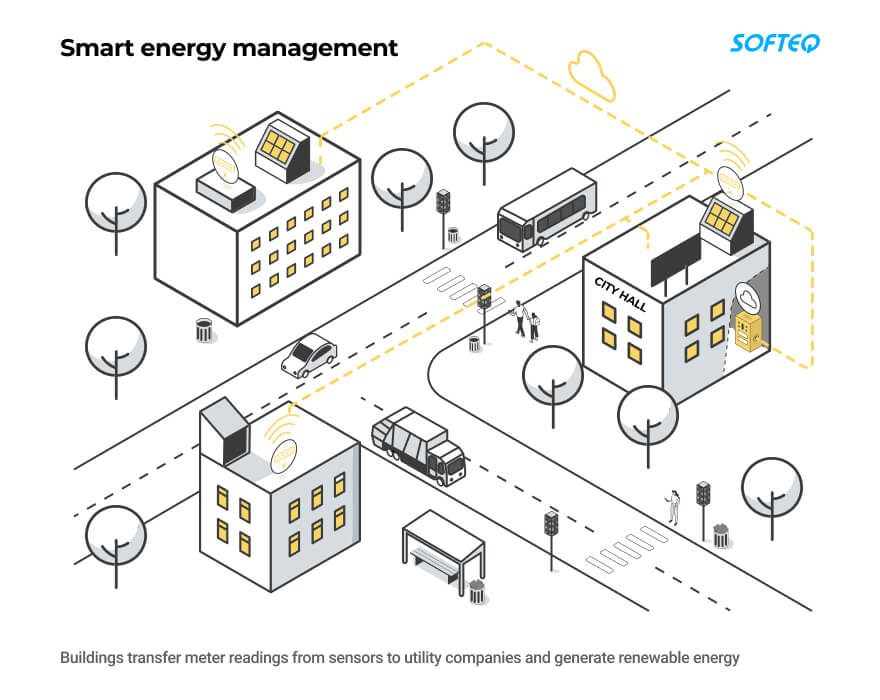
Smart transportation
When we mention transportation in connected cities, we think about self-driving cars. But city traveling requires much more than just a vehicle. With smart city technology, transport companies can provide convenient and fast public transportation. IoT systems help analyze fill rates, optimize routes, and react immediately to incidents. Even a slight change in schedules can improve traffic rates and reduce CO2 emissions.
There are many solutions to boost city traveling. These include:
- Smart traffic signal control systems
- Speed cameras
- Intelligent public transport systems
- Smart payment systems
- Electric carsharing
- Smart parking solutions
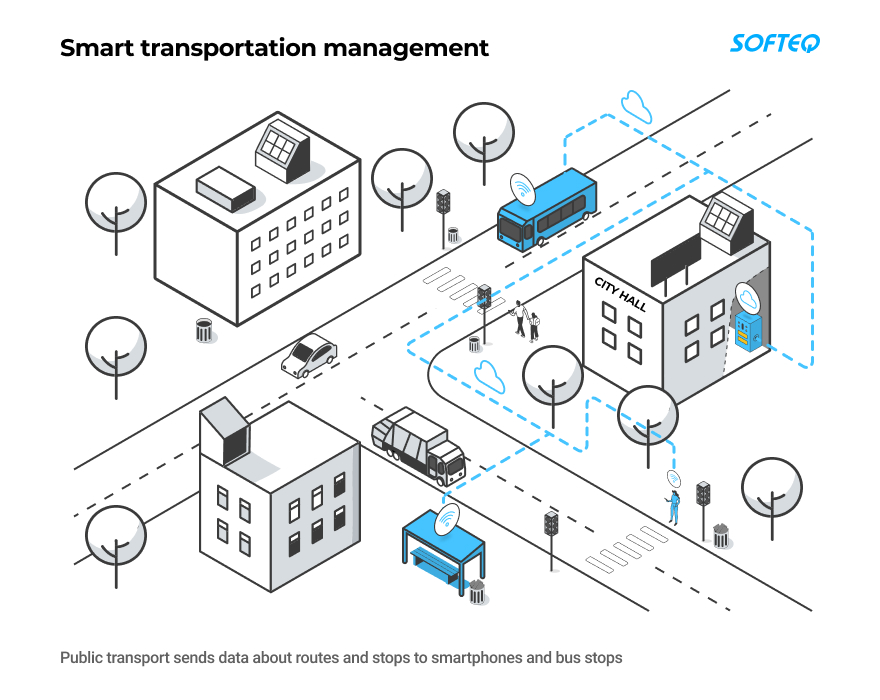
All of these help local authorities manage city resources both smartly and wisely. The results can be seen on the streets: fewer accidents and no traffic jams. From the sustainability side, cities get cleaner air and consume less energy, helping the city budget.
Big cities around the globe lead in deploying smart transportation systems. New York attaches cameras and sensors at city intersections. Berlin integrates e-carsharing and builds new charging stations. Seoul adds sensors around the city to reduce traffic, invests in connected vehicles, and builds 5G infrastructure.
Smart waste management
Most American cities collect waste the same way they did fifty years ago. But San Francisco, the American king of recycling, proves that they can do better. The city saw a profit when technology was added to its recycling and composting programs. Smart container-line robots clean up and recover plastic after optical sorters. Optical sorters can’t differentiate between thermoform and bottle PET, but robots can, thus increasing recycling rates.
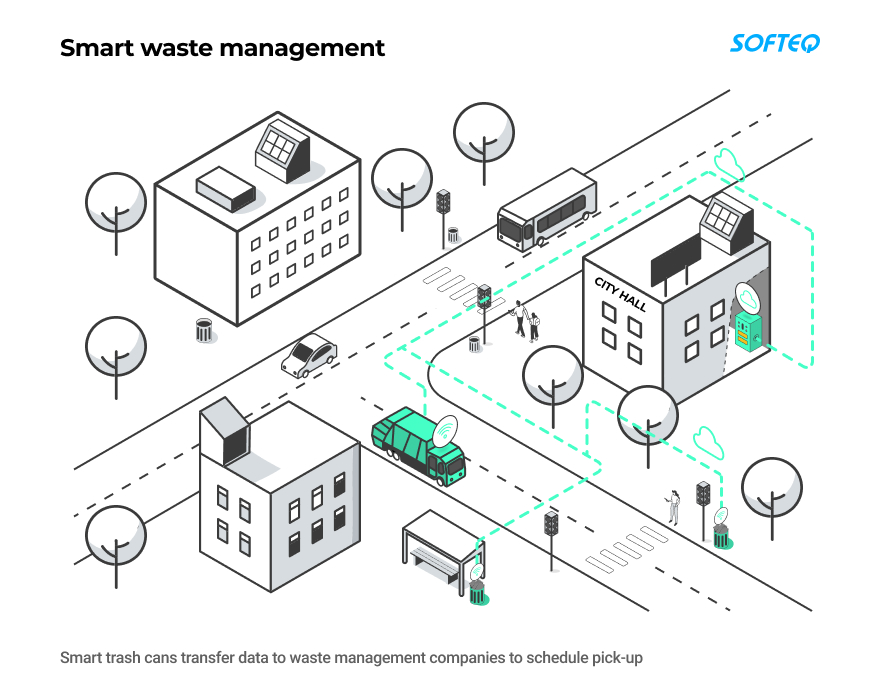
In general, IoT-based smart waste management brings lots of benefits to the city by:
- decreasing the frequency of trash collection
- cutting costs on ineffective waste management
- and reducing CO2 emissions and traffic congestion
Sensors on containers watch trash levels and detect overflows, fires, and illegal interference. ML algorithms help make predictions on waste pickups, the workload for collectors, and the spread of bins across the city. Waste management companies can boost operational efficiency and increase financial profit.
Key Takeaways
Today’s cities are looking for companies to help them become greener. Urban areas need “green” business models and somebody who will scale existing tech solutions for clean energy. This might be IoT companies in climate tech or businesses from oil & gas to utility. New business talent and technical advances are wanted to:
- make energy supply and distribution more efficient
- improve waste collection and management
- get better air quality
- and decrease the level of traffic
So maybe you want to take advantage of new business models and smart solutions for your city. Softeq professionals will help you shape the idea and implement a tech-rich solution that's ready to leave the nest.
More articles on the topic
